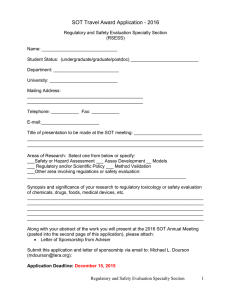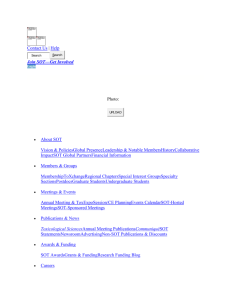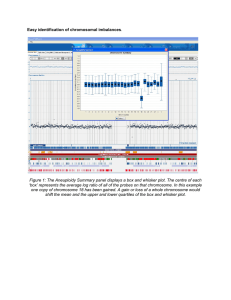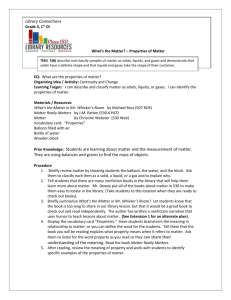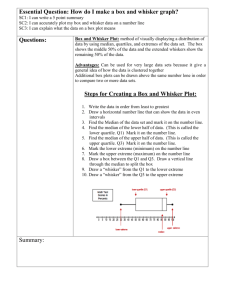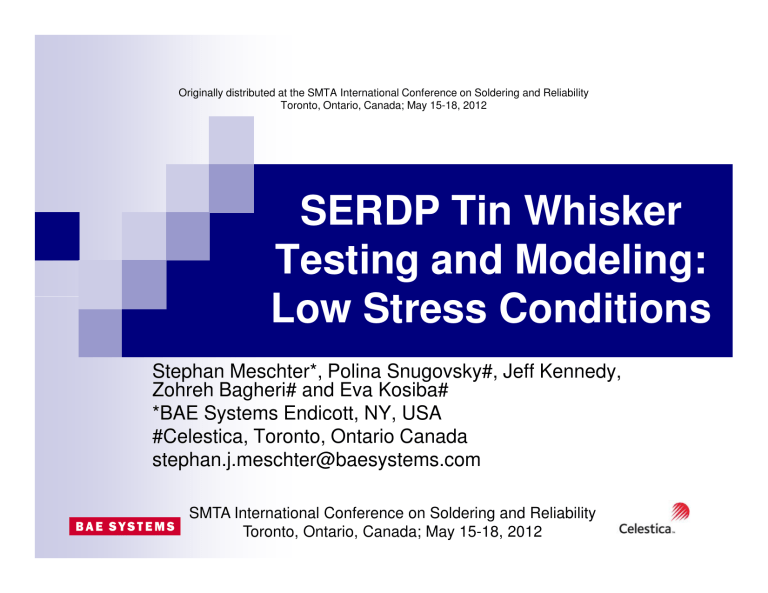
Originally distributed at the SMTA International Conference on Soldering and Reliability Toronto, Ontario, Canada; May 15-18, 2012 SERDP Tin Whisker Testing and Modeling: Low Stress Conditions Stephan Meschter*, Polina Snugovsky#, Jeff Kennedy, Zohreh Bagheri# and Eva Kosiba# *BAE Systems Endicott, NY, USA #Celestica, Toronto, Ontario Canada stephan.j.meschter@baesystems.com SMTA International Conference on Soldering and Reliability Toronto, Ontario, Canada; May 15-18, 2012 SERDP Lead-Free Projects Strategic Environmental Research and Development Program (http://www.serdp.org/) 2 SERDP performs research related to environmental challenges faced by the US Department of Defense WP-1751, J. Nielsen, The Role of Trace Elements in Tin Whisker Growth WP-1752, P. Borgesen, Microstructurally Adaptive Constitutive Models for Lead Free Solder Joints WP-1753, S. Meschter, Tin-Whisker Testing and Modeling WP-1754, E. Hoffman, Stress State and Metallic Whisker Growth WP-2212, D. Hillman, Tin Whiskers Inorganic Coatings Evaluation WP-2213, S. Meschter, Composite coating for whisker mitigation SERDP Project WP1753 Technical objective Perform systematic tin-whisker testing to improve the reliability of military electronics Assess combinations of whisker growth variables Evaluate conformal coating for mitigation effectiveness Provide metallurgical analysis of tin whiskers for nucleation and growth-mechanism formulation Provide an analytical framework to assess functional risk of whiskers to military electronic systems 3 Design, manufacturing, and environments System function risk assessment through integration of whisker distribution data and circuit details Whiskers in typical Pb-free solder joints No lead(Pb) in electroplated Sn finish – propensity for whisker formation Poorer wetting – more exposed Sn plating for same type of components More aggressive fluxes to improve wetting – ionic contamination, oxidation and corrosion promoting whisker growth Sn-Ag-Cu solder – what about whisker growth? 4 Rough surface – trapped contamination, difficult to clean – higher propensity to whisker Exposed Sn Solder Shrinkage void cross-section top view Lead-Free joint roughness, SEM Testing overview Environment INPUTS (factors) OUTPUTS (responses) Temperature Whisker occurrence/length Humidity Thermal cycling PROCESS: Whisker density Bias voltage Assembly Bias Voltage SAC 305 Whisker growth Assy cleanliness Whisker morphology (straight or kinked) Conformal coat penetration Whisker angle Lead material Parts Part cleanliness Package type Whisker diameter Measured on selected samples Metallurgy Test matrix includes variable combinations expected to yield low, medium and high whisker propensities in order to evaluate conformal coat mitigation 5 Variable stress whisker testing Corrosion Stress High Isothermal Humidity 85°C/85RH Thermal Cycle -55C/85 °C Long Term Isothermal Humidity 25 °C/85RH Extra long: 3 year test Low Lead IMC stress: Higher with intermetallic growth Higher with long test duration Montoring IMC thickness on both board and leads during test Lead thermal cycle CTE stress: Higher with larger delta T Higher with tin on alloy 42 Lower with tin on copper Power Cycling Simulation Thermal Cycle 50 °C to 85 °C Low Current work Power Cycling 6 Simulation Lead Stress High Evaluating a broad range of stress combinations suspected to promote whisker growth Factors contributing to whisker growth Compressive stress in tin is believed to cause to whisker growth. Whisker growth from Pb-free solder Corrosion product formation and grain boundary oxidation Whisker Corrosion product formation and grain boundary oxidation Surface oxide Solder intermetallic particle changes (distribution, shape, composition) Tin Plating Lead-free “tin rich” solder alloy 7 Tin whisker growth from thin tin on a substrate Tin thermal expansion Substrate thermal expansion Substrate Intermetallic Test vehicle panel Board Types SOT (Small outline transistor) Current work BGA (Ball grid array) QFP/PLCC (Quad flat pack/ Plastic leaded chip carrier) 24.7 x 20 cm 0.236 mm thick panel 8 Test Vehicle 6 cm square Can be inspected entirely in the SEM Designation Part No. Package Lead Frame Material Plating Material Number of Leads/ number of parts SOT3 2N7002 SOT23-3 SOT5 NC7S08M5X SOT23-5 SOT6 2N7002DW-7-F SOT363 Alloy 42 Matte Sn 3/64 Cu194 Matte Sn 5/40 Alloy 42 Matte Sn 6/17 Alloy 42 C194 Fe-42Ni Cu2.1-2.6Fe-0.015-0.15P-0.05-0.2Zn Immersion tin finish printed wire board SOT3 9 SOT5 SOT6 Electrical Bias SOT23-3 5V Bias SOT23-3 Ground SOT23-5 5V Bias SOT3 SOT5 SOT23-5 Ground SOT-6 No bias No connect SOT6 5V applied to Qty = 32 SOT23-2, Qty = 20 SOT23-5 10 10 Simulated power cycling environment 50 °C ambient on-off simulation Chamber air determines board temperature Constant voltage applied 31 mA board current draw @ 5V = 155 mW Low power yields small temperature gradients Low range thermal cycling Target 50 to 85 °C, 35 °C Measured 48 °C to 88 °C, ∆T=40 °C Humidity was recorded 11 Cycling 25%RH at 88 °C to 10%RH at 48 °C COMPONENTS, AS RECEIVED 12 Components, SOT23-3 as received Sn plating thickness varies from 5 to 20 µm depending on lead area 13 Components, SOT23-3 as received (cont.) No significant anomalies in plating Protrusion Uneven surface with voids 14 Components, SOT23-3 as received (cont.) EDX on Alloy 42 Leadframe Material 15 Element Weight% Atomic% Mn K 0.56 0.58 Fe K 59.12 60.30 Ni K 40.33 39.13 Totals 100.00 Components, SOT23-3 as received (cont.) Lead Gap Plastic body Exposed Alloy 42 Some Silicon contamination before cleaning 16 Components, SOT363 as received 17 Sn plating thickness varies from 2 to 25 µm depending on lead area Components, SOT363 as received (cont.) No significant anomalies in plating Rough surface with deep groves 18 Voids Components, SOT363 as received (cont) Exposed Alloy 42 19 Components, SOT23-5 as received Sn plating thickness varies from 5 to 29 µm depending on lead area 20 Components, SOT23-5 as received Skipped Sn plating 21 Components, SOT23-5 as received Sn plating is more uniform and smother than on SOT23-3 and SOT363 Defects the Intermetallic layer related to Fe3P Fe3P Protrusion 22 Components, SOT23-5 as received Fe3P 23 Element Weight% Atomic% PK 13.26 21.74 Fe K 81.00 73.67 Cu K 5.74 4.59 Totals 100.00 Components, SOT23-5 as received Exposed Cu Alloy C194 24 Components For Assembly • Before Assembly components were divided into 2 groups – The first group was cleaned – Method developed in Screening Experiments was used – The second croup was contaminated with NaCl – Method developed in Screening Experiments was used – 3µg/in2 intended • Each group was assembled using SAC305 solder paste and washed after assembly • Assembled boards were divided into two groups – The first group was left clean – Cleaned Components/Clean Boards – 0-0 – Contaminated Components/ Clean Boards – 1-0 – The second group was contaminated with NaCl – 10µg/in2 intended – Cleaned Components/Contaminated Boards – 0-1 – Contaminated Components/ Contaminated Boards – 1-1 25 COMPONENTS, CLEANED 26 Components Before Cleaning Component Name Component ID Total Inorganic anions (µg/in²) Total Organic anions (µg/in²) SOT 23-3 2N7002(3 leads) 0.4 3.3 SOT 23-5 NC 7S 08 M5X (5 leads) 0.3 0.0 SOT 363 2N7002DW(6 leads) 0.2 3.5 QFP 64 LQFP 64 0.4 3.1 QFP 44 QFP 44 0.2 2.4 PLCC 20 3.7 0.0 PLCC 20 27 Components After Cleaning • Cleaning: – The samples were cleaned twice – Placed in a KPak® bag with a solution of 10% IPA / 90% v/v deionized water and sealed. – 40 minutes in steam bath at 80°C and – 40 minutes on shaker table and then – Baked at 60°C for 10 minutes. Concentration of Inorganic anions in µg/in2 Fluoride Chloride Nitrite Bromide Nitrate Sulphate Total inorganic SOT 23-3 0.0 0.0 0.0 0.0 0.2 0.2 0.4 SOT 23-5 0.1 0.0 0.0 0.0 0.1 0.0 0.3 SOT 363 0.1 0.0 0.0 0.0 0.1 0.0 0.2 QFP 64 0.1 0.0 0.0 0.0 0.2 0.1 0.4 QFP 44 0.1 0.0 0.0 0.0 0.1 0.0 0.2 PLCC 20 0.2 0.2 0.0 0.0 0.1 3.1 3.7 Component The level of contamination is much below the recommended minimum 28 Cleanliness Requirements Terry Manson: Foresite table Industry accepted limit of contamination (our customers’ requirements) - 10.75 µg/in2 total inorganic 29 COMPONENTS, CONTAMINATED 30 Components After Pre-build Contamination • • Intention was to have SOT23-3 level of contamination 3.0µg/in2 ClMore contamination was trapped by SOT363 and SOT23-5 because of rougher surface and more gaps than in SOT23-3 Component Name Component ID Total Inorganic anions (µg/in²) Total Organic anions (µg/in²) SOT 23-3 2N7002(3 leads) 1.9 0.0 SOT 23-3 repeat 2N7002(3 leads) 2.3 0.0 SOT 23-5 NC 7S 08 M5X (5 leads) 8.7 0.0 SOT 363 2N7002DW(6 leads) 7.4 0.0 QFP 64 LQFP 64 7.9 0.0 PLCC 20 PLCC 20 25 0.0 31 Components After Pre-build Contamination (cont.) Concentration of Inorganic anions in µg/in2 Fluoride Chloride Nitrite Bromide Nitrate Sulphate Total inorganic SOT 23-3 0.1 1.7 0.0 1.0 0.0 0.1 1.9 SOT 23-3 repeat 0.1 2.2 0.0 0.0 0.0 0.0 2.3 SOT 23-5 0.3 6.7 0.0 0.0 0.0 0.7 8.7 SOT 363 0.1 7.2 0.0 0.0 0.1 0.1 7.4 QFP 64 0.1 7.7 0.0 0.0 0.0 0.1 7.9 PLCC 20 0.1 24.7 0.0 0.1 0.0 0.1 25.0 Component The level of contamination is above the recommended minimum Chloride content: SOT23-3 – 2X above recommendation, but 2X below the level previously encountered in production SOT23-5, SOT363, and QFP624 – comparable to what may happen in production PLCC20 – very high level 32 Components Pre-build Contamination: SOT23-3, Cl- - 1.7-2.2µg/in2 • Mostly silicon containing contamination was detected • Chloride was found only in several occasions 33 Components Pre-build Contamination: SOT23-5, Cl- - 6.7µg/in2 • Chloride containing contamination in surface roughness and gaps 34 Components Pre-build Contamination: SOT363, Cl- - 7.2µg/in2 • Chloride containing contamination are widely spread in surface roughness, grain boundaries and gaps 35 ASSEMBLY 36 Assembled Boards • • Cleaned and Contaminated components were assembled using SAC305 solder paste and washed after assembly Assembled boards were divided into two groups – The first group was left clean – Cleaned Components/Clean Boards – 0-0 no conformal coating – Contaminated Components/ Clean Boards – 1-0 no conformal coating – The second group was coated using UV40 – Cleaned Components/Clean Boards – 0-0 with conformal coating – Contaminated Components/ Clean Boards – 1-0 with conformal coating – Each of four types of SOT boards was divided into two groups – The first group is left clean – The second group was contaminated with NaCl – 10µg/in2 intended – Cleaned Components/Contaminated Boards – 0-1 – Contaminated Components/ Contaminated Boards – 1-1 • Eight types of SOT boards were recieved: – 0-0, 1-0, 0-1, 1-1 no conformal coating – 0-0, 1-0, 0-1, 1-1 with conformal coating 37 Assembled Boards: Post Assembly Contamination • Two solutions for post assembly contamination: – 250 +/- 10 ppm for – SOT boards with conformal coating – 160 +/- 10 ppm for – SOT boards no conformal coating – QFP boards without conformal coating – QFP boards with conformal coating • • • Ion Chromatography results (IC) Chloride in ppm – about 5 ppm Chloride in µg/in2 - 9.6 to 12.8 µg/in2 Sample ID Board 237 - SOT - not coated Board 217 – SOT - coated Board 219 - SOT - coated 38 IC – Chloride, ppm Chloride Conc. µg/in2) 5.2 12.5 5.3 12.8 4.0 9.6 Solder Coverage:SOT23-3 • SOT23-3 is fully covered with solder IMC on board – 2.7µm 39 IMC on lead - 0.4µm Solder Coverage: SOT23-3 • Some Cl was found trapped at the thinnest part of the joint between the lead and Cu pad 40 Element Weight% Atomic% Cl K 1.21 3.78 Fe K 2.07 4.08 Ni K 0.95 1.78 Cu K 1.59 2.77 Sn L 94.18 87.59 Totals 100.00 Solder Coverage: SOT363 • SOT363 is fully covered with solder Corrosion ? IMC on board - 2.6µm 41 IMC on lead - 0.3µm Solder Coverage: SOT23-5 • The top part of the leads of SOT23-5 is not covered with solder IMC on board - 2.6µm 42 IMC on lead - 1.1µm

